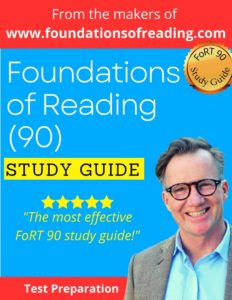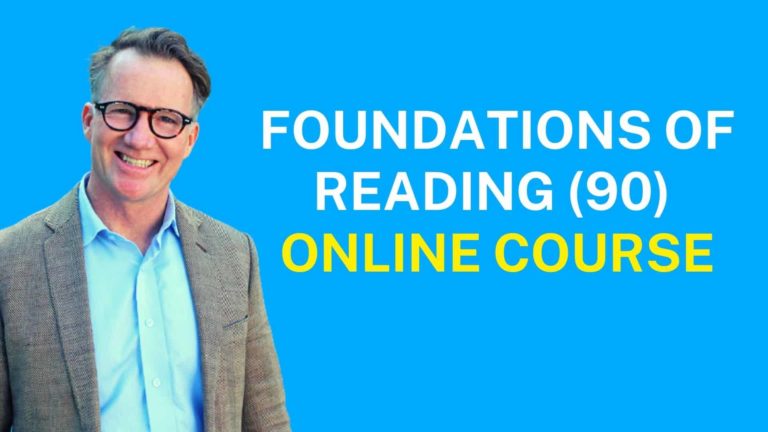
How to Pass the Foundations of Reading 90 Test
Passing the FoRT 90 test is required by many states in order to begin a career as a credentialed teacher.
The Most Difficult Reading Test
According to this article, the passing rate for the Foundations of Reading test is only 61.5% for all test takers.
For first-time FoRT takers, the passing rate is only 60.2%.
“The Foundations of Reading Test has a 61.5% pass rate.”
Credentialed Teachers Make More
Did you know that credentialed teachers make on average $7,100 more than non-credentialed teachers?
The result of your Foundations of Reading test is too important to your future career earnings and immediate job placement to not take action to study with the best test preparation available.
Use the foundationsofreading.com bundle package and pass your FoRT on the next try.
Ace the FoRT 90
FoRT 90 Study Guide
"Best for reading learners"

Foundations of Reading 90 Structure and Overview
About the test
The Foundations of Reading test aims to measure the examinee’s understanding of in-depth, research-based reading and writing development.
Who needs to take the test?
People applying to become a K-6 elementary school teacher or a K-12 teacher in special education are required to pass the Foundations of Reading test.
The stand-alone reading assessment requirements apply to the following:
- Teachers placed on an Additional Licensure Plan (ALP) for Special Education K–12 or Elementary Education K–6 beginning in the fall of the 2017–2018 school year will be required to meet the changes to licensure assessments;
- Teachers applying for reciprocity after September 1, 2017, for Elementary Education K–6 and Special Education K–12 are required to meet these requirements if the teacher has less than three (3) years documented teaching experience. A provisional license will be available for reciprocity candidates, if needed;
- Teachers who enroll in a Special Education K–12 or Elementary Education K–6 program that begins in the fall of 2017, and thereafter. (Candidates who enrolled in a Special Education K–12 or Elementary Education K–6 program and started their coursework prior to the fall of 2017 do not have to take the stand-alone reading test.);
- The requirements of Act 416 also apply to currently licensed teachers testing out of the K–6 endorsement after September 1, 2017. These teachers must also meet all other licensure requirements in place at the time of licensure application.
Test information
Test name | Foundations of Reading |
Test number | 90 |
Number and type of questions | 100 multiple-choice questions; 2 constructed-response questions |
Test format | Computer-based test (CBT) and online proctored test |
Test to take the test | 4 hours testing time |
Taking breaks during the test | You can take breaks during the test, but the test timer continues while you take a break |
Passing score | State-determined |
Subarea breakdown |
|
Multiple-choice breakdown
Subarea | Range of objectives | Approximate test weight of subarea |
1: Foundations of Reading Development | 01-04 | 35% |
2: Development of Reading Comprehension | 05-07 | 27% |
3: Reading Assessment and Instruction | 08-09 | 18% |
Open-response breakdown
4: Foundations Reading Skills | 10 | 10% |
4: Reading Comprehension | 11 | 10% |
Test framework
Subarea 1: Foundations of Reading Development
Objective 0001: Understand phonological and phonemic awareness
- For example: the distinction between phonological awareness (i.e., the awareness that oral language is composed of smaller units, such as spoken words and syllables) and phonemic awareness (i.e., a specific type of phonological awareness involving the ability to distinguish the separate phonemes in a spoken word); the role of phonological awareness and phonemic awareness in reading development; the difference between phonemic awareness and phonics skills; levels of phonological and phonemic awareness skills (e.g., rhyming, segmenting, blending, deleting, substituting); strategies (e.g., explicit, implicit) to promote phonological and phonemic awareness (e.g., distinguishing spoken words, syllables, onsets/rimes, phonemes); and the role of phonological processing in the reading development of individual students (e.g., English Language Learners, struggling readers through highly proficient readers).
Objective 0002: Understand concepts of print and the alphabetic principle
- For example: development of the understanding that print carries meaning; strategies for promoting awareness of the relationship between spoken and written language; the role of environmental print in developing print awareness; development of book handling skills; strategies for promoting an understanding of the directionality of print; techniques for promoting the ability to track print in connected text; strategies for promoting letter knowledge (e.g., skill in recognizing and naming upper-case and lower-case letters); letter formation; strategies for promoting understanding of the alphabetic principle (i.e., the recognition that phonemes are represented by letters and letter pairs); use of reading and writing strategies for teaching letter-sound correspondence; and development of alphabetic knowledge in individual students (e.g., English Language Learners, struggling readers through highly proficient readers).
Objective 0003: Understand the role of phonics in promoting reading development
- For example: explicit strategies for teaching phonics; the role of phonics in developing rapid, automatic word recognition; the role of automaticity in developing reading fluency; interrelationships between decoding, fluency, and reading comprehension; the interrelationship between letter-sound correspondence and beginning decoding (e.g., blending letter sounds); strategies for helping students decode single-syllable words that follow common patterns (e.g., CVC, CVCC, CVVC, CVCe) and multisyllable words; methods for promoting and assessing the use of phonics generalizations to decode words in connected text; use of semantic and syntactic clues to help decode words; the relationship between decoding and encoding (e.g., analyzing the spellings of beginning readers to assess phonics knowledge, using spelling instruction to reinforce phonics skills); strategies for promoting automaticity and fluency (i.e., accuracy, rate, and prosody); the relationship between oral vocabulary and the process of decoding written words; specific terminology associated with phonics (e.g., phoneme, morpheme, consonant digraph, consonant blend); and development of phonics skills and fluency in individual students (e.g., English Language Learners, struggling readers through highly proficient readers).
Objective 0004: Understand word analysis skills and strategies
- For example: development of word analysis skills and strategies in addition to phonics, including structural analysis; interrelationships between word analysis skills, fluency, and reading comprehension; identification of common morphemes (e.g., base words, roots, inflections and other affixes); recognition of common prefixes (e.g., un-, re-, pre-) and suffixes (e.g., -tion, -able) and their meanings; knowledge of Latin and Greek roots that form English words; use of syllabication as a word identification strategy; analysis of syllables and morphemes in relation to spelling patterns; techniques for identifying compound words; identification of homographs (i.e., words that are spelled the same but have different meanings and may be pronounced differently [e.g., bow, part of a ship/bow, to bend from the waist; tear, a drop of water from the eye/tear, to rip]); use of context clues (e.g., semantic, syntactic) to help identify words and to verify the pronunciation and meaning of words; and development of word analysis skills and fluency in individual students (e.g., English Language Learners, struggling readers through highly proficient readers).
Subarea II- Development of Reading Comprehension
Objective 0005: Understand vocabulary development
- For example: the relationship between oral and written vocabulary development and reading comprehension; the role of systematic, noncontextual vocabulary strategies (e.g., grouping words based on conceptual categories and associative meanings) and contextual vocabulary strategies (e.g., paraphrasing); the relationship between oral vocabulary and the process of identifying and understanding written words; strategies for promoting oral language development and listening comprehension (e.g., read-alouds, word explanation strategies); knowledge of common sayings, proverbs, and idioms (e.g., raining cats and dogs, better safe than sorry); knowledge of foreign words and abbreviations commonly used in English (e.g., RSVP); criteria for selecting vocabulary words; strategies for clarifying and extending a reader’s understanding of unfamiliar words encountered in connected text (e.g., use of semantic and syntactic clues, use of word maps, use of the dictionary); strategies for promoting comprehension across the curriculum by expanding knowledge of academic language, including conventions of standard English grammar and usage, differences between the conventions of spoken and written standard English, general academic vocabulary, and content-area vocabulary (e.g., focus on key words); the importance of frequent, extensive, varied reading experiences in the development of academic language and vocabulary; and development of academic language and vocabulary knowledge and skills in individual students (e.g., English Language Learners, struggling readers through highly proficient readers).
Objective 0006: Understand how to apply reading comprehension skills and strategies to imaginative/literary texts
- For example: knowledge of reading as a process to construct meaning; knowledge of reading comprehension and analysis skills for reading literature (e.g., analyzing a text’s key ideas and details, interpreting an author’s use of craft and structure, integrating knowledge and ideas from multiple literary works); knowledge of levels of reading comprehension (i.e., literal, inferential, and evaluative) and strategies for promoting comprehension of imaginative/literary texts at all three levels; strategies for promoting close reading of imaginative/literary texts; development of literary response skills (e.g., connecting elements in a text to prior knowledge and other sources; using evidence from a text to support analyses, develop summaries, and draw inferences and conclusions); development of literary analysis skills (e.g., identifying features of different literary genres, analyzing story elements, analyzing character development, interpreting figurative language, identifying literary allusions, analyzing the author’s point of view); use of comprehension strategies to support effective reading (e.g., rereading, visualizing, reviewing, self-monitoring and other metacognitive strategies); use of oral language activities to promote comprehension (e.g., retelling, discussing); the role of reading fluency in facilitating comprehension; use of writing activities to promote literary response and analysis (e.g., creating story maps and other relevant graphic organizers; comparing and contrasting different versions of a story, different books by the same author, or the treatment of similar themes and topics in different texts or genres); and development of the reading comprehension skills and strategies of individual students (e.g., English Language Learners, struggling readers through highly proficient readers).
Objective 0007: Understand how to apply reading comprehension skills and strategies to informational/expository texts
- For example: knowledge of reading comprehension and analysis skills for reading informational text (e.g., explaining key ideas and details in an informational text, analyzing the craft and structure used in an expository or persuasive text, integrating knowledge and ideas from multiple print or digital sources); knowledge of levels of reading comprehension (i.e., literal, inferential, and evaluative) and strategies for promoting comprehension of informational/expository texts at all three levels; strategies for promoting close reading of informational/expository texts, including strategies for identifying point of view, distinguishing facts from opinions, analyzing multiple accounts of the same event or topic, determining how an author uses reasons and evidence to support particular points in a text, and detecting faulty reasoning in informational/expository texts; use of reading strategies for different texts and purposes (e.g., adjusting reading rate based on text difficulty, skimming/scanning); use of comprehension strategies to support effective reading (e.g., rereading, visualizing, self-questioning, paraphrasing); use of oral language activities to promote comprehension (e.g., using evidence in an informational/expository text to explain concepts, events, ideas, or procedures); the role of reading fluency in facilitating comprehension of informational/expository texts; use of writing activities to promote comprehension (e.g., student-generated questioning, note taking, outlining, summarizing, semantic maps); knowledge of text structures (e.g., chronological, comparison/contrast, cause/effect); use of text features (e.g., index, glossary), graphic features (e.g., illustrations, charts, maps), and reference materials; application of comprehension strategies to electronic texts; development of students’ ability to apply reading comprehension skills for varied purposes; and development of the reading comprehension skills and strategies of individual students (e.g., English Language Learners, struggling readers through highly proficient readers).
Subarea III - Reading Assessment and Instruction
Objective 0008: Understand formal and informal methods for assessing reading development
- For example: the use of data and ongoing reading assessment to adjust instruction to meet students’ reading needs; the characteristics and uses of standardized criterion-referenced and norm-referenced tests to assess reading development and identify reading difficulties; concepts of validity, reliability, and bias in testing; the characteristics and uses of formal and informal reading-related assessments (e.g., assessment of phonemic awareness, miscue analyses, Informal Reading Inventories, running records, use of rubrics, portfolio assessment, assessment of authentic tasks); characteristics and uses of group versus individual reading assessments; techniques for assessing particular reading skills (e.g., oral or written retellings to assess reading comprehension, dictated word lists to test letter-sound knowledge); awareness of text leveling; awareness of the challenges and supports in a text (e.g., pictures, predictability, decodability); techniques for determining students’ independent, instructional, and frustration reading levels; and assessment of the reading development of individual students (e.g., English Language Learners, struggling readers through highly proficient readers).
Objective 0009: Understand multiple approaches to reading instruction
- For example: knowledge of the significant theories, approaches, practices, and programs for developing reading skills and reading comprehension; strategies for planning, organizing, managing, and differentiating reading instruction to support the reading development of all students; adjustment of reading instruction based on ongoing assessment; instructional strategies for promoting development of particular reading skills (e.g., phonemic awareness, phonics skills, word identification, automatic recognition of sight words, vocabulary knowledge); the importance of close reading and rereading of well crafted, content- and idea-rich texts in reading development; strategies for evaluating and sequencing texts for reading instruction according to text complexity; the importance of balancing students’ exposure to and reading of literary and informational texts; the uses of large-group, small-group, and individualized reading instruction; strategies for selecting and using meaningful reading materials at appropriate levels of difficulty; creation of an environment that promotes love of reading; strategies for promoting independent reading in the classroom and at home; uses of instructional technologies to promote reading development; and awareness of strategies and resources for supporting individual students (e.g., English Language Learners, struggling readers through highly proficient readers).
Subarea IV- Integration of Knowledge and Understanding
Objective 0010: Prepare an organized, developed analysis on a topic related to one or more of the following: foundations of reading development; development of reading comprehension; reading assessment and instruction
- For example: the role of phonological and phonemic awareness in reading development; development of alphabetic knowledge; role of phonics in developing rapid, automatic word recognition; development of word analysis skills and strategies in addition to phonics, including structural analysis; the relationship between vocabulary development and reading comprehension; use of strategies to enhance comprehension of imaginative/literary texts; knowledge of organizational patterns in informational/expository texts; techniques for assessing particular reading skills; and strategies for planning, organizing, managing, and differentiating reading instruction to support the reading development of all students.


